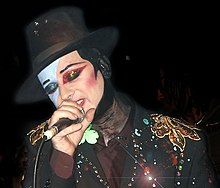Second British Invasion
[8] In 1979, "Roxanne" by the Police cracked the American Top 40, followed by the more modest chart successes of Elvis Costello,[9] Sniff 'n' the Tears,[10] the Pretenders, Gary Numan, Squeeze, and Joe Jackson; the latter scored a new wave hit with "Is She Really Going Out with Him?
[11][12] At the same time, pop and rock music in the U.S. was undergoing a creative slump due to several factors, including audience fragmentation and the effects of the anti-disco backlash that reached its peak with Disco Demolition Night.
"[5] In 2011, The Guardian felt that the launch of MTV (one of the paper's "50 key events in the history of pop music") played "a huge part" in the second British invasion.
The trend was particularly strong in Manhattan where import records and the British music press were convenient to obtain and where the New York Rocker warned that "Anglophilia" was hurting US underground acts.
[15] "Some fascinating new music began arriving on these shores; it was dubbed electropop, because electronic instrumentation — mainly synthesizers and syndrums — was used to craft pop songs.
The song peaked at number five on the UK Top 40 chart in late June 1982,[17] and its accompanying music video received frequent rotation on MTV by early July.
[5] The September 1982 arrival of MTV in the media capitals of New York City and Los Angeles led to widespread positive publicity for the new "video era".
[12] Billy Idol became an MTV staple with 1983's "White Wedding" and 1984's "Eyes Without a Face", and his second studio album Rebel Yell (1983) sold two million copies.
[19] Pop rock songs that topped the charts included Bonnie Tyler's "Total Eclipse of the Heart", John Waite's "Missing You", and Robert Palmer's "Addicted to Love".
[12][22] Rock-oriented acts that knew how to use video, such as Def Leppard, Big Country and Simple Minds, became part of the new influx of music from Britain.
On 16 July 1983, twenty of the top forty singles were British, surpassing the previous record of 14 set in 1965;[12][23] this tally was equaled the weeks ending 31 May – 7 June 1986.
released the 1984 US chart-topper "Wake Me Up Before You Go-Go"; its music video featured oversized message T-shirts created by Katharine Hamnett, starting a craze covered in the 2002 VH1 series I Love the 80s.
[32] At the Second Invasion's height, during a five-month period, UK acts claimed nine out of the eleven Hot 100 number-one hits, from Simple Minds' "Don't You (Forget About Me)" through to Dire Straits' "Money for Nothing".
"Don't You (Forget About Me)", which features in The Breakfast Club (1985), rendered Simple Minds the first British act to achieve a Hot 100 hit with a single taken from a Brat Pack film soundtrack; subsequent artists included John Parr and the Psychedelic Furs, who recorded the title tracks of St. Elmo's Fire (1985) and Pretty in Pink (1986), respectively (the former reaching number one).
[35] Orchestral Manoeuvres in the Dark – who had been an early presence in the invasion[36] – entered the top five with the "zeitgeist-capturing" hit single "If You Leave", which plays prominently during Pretty in Pink's climactic "prom scene".
1, Yes with "Owner of a Lonely Heart" achieving the same, and the Alan Parsons Project with "Sirius", which would be used as entrance music by various US sports teams, notably the Chicago Bulls.
Much like the first great explosion of pop culture upon mass consciousness, which commenced with the Beatles' arrival in America in February 1964, the primary impetus for all this has been emanating from the far side of the Atlantic.
Commentators in the mainstream media credited MTV and the British acts with bringing colour and energy back to pop music that had been missing since the 1960s, while rock journalists were generally hostile to the phenomenon because they felt it represented image over content and that the "English haircut bands" had not paid their dues.
The visual angle played to the arty conceits of Britain's young style barons, suggesting something more exotic than the viewer was likely to find in the old hometown.
However, by 1983, the song "Rip It Up" by Scottish rock band Orange Juice[citation needed] and "kill ugly pop stars" graffiti were expressions of both a backlash against the Second Invasion groups and nostalgia for punk.
[46][47] According to music journalist Simon Reynolds, a majority of acts that signed to independent labels in 1984 mined various rock influences and became an alternative to the Second Invasion.
US hits from these bands included "Wannabe" (Spice Girls), "Wonderwall" (Oasis), "Song 2" (Blur), "Back for Good" (Take That), and "Bitter Sweet Symphony" (the Verve).



